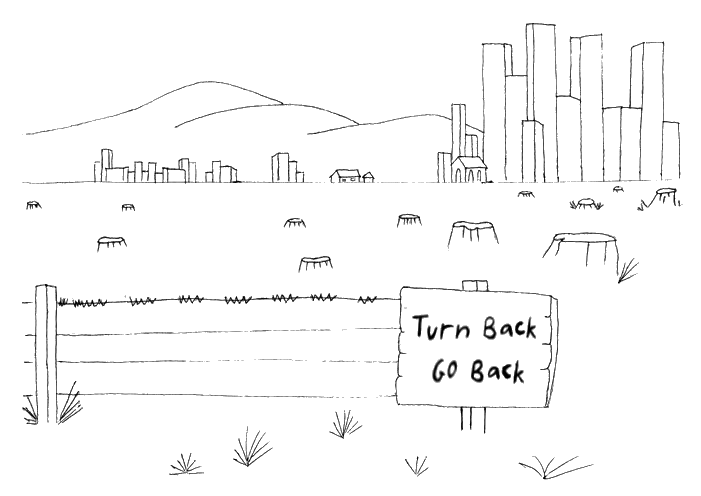

Environment
Landcare and the Murray Darling Basin > Saving the Murray > Life & Death of the BillabongUnderstanding Environmental Economics > How to be Green
Understanding Environmental Economics
(Melbourne, Australia, Longman Cheshire Pty Ltd, 1992)
[Bridget Sant]
1
Environmental economics is concerned with the whole range of environmental issues. These can be divided into three categories:
resource depletion, residual generation and ecosystem destruction. Resource depletion refers to the decrease in quantity and quality of available resources,
both those which are thought of as renewable, such as soil and water, as well as those that are non-renewable, such as fossil fuels and metals.
Residual generation is simply the accumulation of gaseous, liquid and solid wastes. Ecosystem destruction is the loss of natural habitat,
mainly through land transformation, reducing biological diversity and the availability of natural environments.
8
But like all resources, they are relatively scarce or can become scarce. This scarcity arises because of the finite nature of the Earth.
Our environment can be considered as a closed system. The only 'input' from outside of any significance is solar energy, but this is matched by Earth's radiation into space
(although this also may be changing due to the Greenhouse Effect). There are also a few 'outputs' in the form of discarded satellites and spent fuel rockets.
Otherwise, all the materials we use for energy, goods and services with which we satisfy our unlimited wants come from this world.
Since we cannot destroy matter but merely change its form - for example, coal when burnt produces energy and carbon dioxide - all our outputs remain on this Earth too.
These outputs are sometimes in a useful form such as roads or buildings, and sometimes as wastes such as garbage or pollution.
10
...However, it is not only our current wants which the Earth must satisfy but also those of future generations. That is, we must provide for inter-generational equity.
It is this idea which gives rise to the concept of sustainable development. The Australian Government's definition of sustainable development is:
'Using, conserving and enhancing the community's resources so that ecological processes on which life depends are maintained and the total quality of life now and in the future can be increased.'
The most widely used definition is that of the Brundtland Commission's report (1987) which defines it as:
'Growth which ensures that it meets the needs of the present, without compromising the ability of future generations to meet their needs.'
The Chernobyl disaster
20
The number of nuclear power stations round the world has been multiplying rapidly. By 1986, 50 per cent of Sweden’s electricity came from nuclear power stations and 26 per cent of Japan’s.
However, the largest number of nuclear power stations at this time was in the United States, followed by the Soviet Union which generated some 11 per cent of its electricity from nuclear power.
Despite this number of potentially lethal nuclear reactors, until 26 April 1986 there had been no known major catastrophe.
The Three Mile Island accident in 1979 in the United States was contained within the building surrounding the plant, which was then permanently sealed.
The disaster at Chernobyl occurred during maintenance and resulted in the cooling system failing. The heat which is produced by the nuclear reaction in the core is normally removed by a system of piped water, and it is this hot water which is used to generate electricity. The breakdown in this cooling system resulted in the build-up of heat, causing hydrogen to
The disaster at Chernobyl occurred during maintenance and resulted in the cooling system failing. The heat which is produced by the nuclear reaction in the core is normally removed by a system of piped water, and it is this hot water which is used to generate electricity. The breakdown in this cooling system resulted in the build-up of heat, causing hydrogen to
21
form. There was a build-up of pressure, causing an explosion which released a cloud of radioactive gas into the atmosphere and a fire in the plant.
Chernobyl is located north of Kiev in the Soviet Republic of the Ukraine. It was a complex of four nuclear power plants with the workers housed in the nearby town of Pripyat.
The effects have been catastrophic: thirty-one people died as a direct consequence of the explosion and fighting the fire and hundreds more have died following the effects of the escaped radioactivity. Some of these deaths occurred within weeks, others as a result of the increased incidence of cancers, particularly leukaemia and thyroid cancer, following exposure to radiation. Other deaths are still occurring because of the breakdown in the immune system and from birth defects as a result of exposure to the radiation. The radioactive cloud released on 26 April moved north-west and as rain fell the radiation was deposited on the ground where it remains contaminating the soil today, thus rendering any food produced there radioactive. The areas which received very high levels of radiation are in the republics of Belorussia and the Ukraine. In Belorussia some 20 per cent of the farm land and 15 per cent of the forest land is now unusable. Radiation did spread further afield into Poland, Germany, Sweden and Britain, but by this time it was more diluted and the main effects were short-term ones. Sales of some locally produced milk, meat and leafy vegetables were banned in these countries. In some areas there is likely to be a marginal increase in the incidence of some cancers.
The Soviet authorities have declared a 30 kilometre exclusion zone round the plant where nobody may live or work, and 116000 people have had to be evacuated and resettled. The continuing problems are mainly in areas outside this zone. These areas also receive lethal doses but the Soviets chose to regard them as safe and, therefore, continued to allow food grown there to be distributed, thus widening the effects of the disaster to people living far away. It is thought millions of people, particularly children, are at risk, both from their food and from living and playing on contaminated ground.
The costs to the Soviet Union are incalculable but must include the loss of electricity production, the decontamination costs, the loss of agricultural production, the rehousing costs and the ongoing increased medical costs. Clearly, this adds up to several hundred billion dollars. The worldwide effects have been to re-assess many nuclear plants, particularly their safety requirements. Sweden has vowed to replace all its nuclear power with environmentally safer alternatives.
The effects have been catastrophic: thirty-one people died as a direct consequence of the explosion and fighting the fire and hundreds more have died following the effects of the escaped radioactivity. Some of these deaths occurred within weeks, others as a result of the increased incidence of cancers, particularly leukaemia and thyroid cancer, following exposure to radiation. Other deaths are still occurring because of the breakdown in the immune system and from birth defects as a result of exposure to the radiation. The radioactive cloud released on 26 April moved north-west and as rain fell the radiation was deposited on the ground where it remains contaminating the soil today, thus rendering any food produced there radioactive. The areas which received very high levels of radiation are in the republics of Belorussia and the Ukraine. In Belorussia some 20 per cent of the farm land and 15 per cent of the forest land is now unusable. Radiation did spread further afield into Poland, Germany, Sweden and Britain, but by this time it was more diluted and the main effects were short-term ones. Sales of some locally produced milk, meat and leafy vegetables were banned in these countries. In some areas there is likely to be a marginal increase in the incidence of some cancers.
The Soviet authorities have declared a 30 kilometre exclusion zone round the plant where nobody may live or work, and 116000 people have had to be evacuated and resettled. The continuing problems are mainly in areas outside this zone. These areas also receive lethal doses but the Soviets chose to regard them as safe and, therefore, continued to allow food grown there to be distributed, thus widening the effects of the disaster to people living far away. It is thought millions of people, particularly children, are at risk, both from their food and from living and playing on contaminated ground.
The costs to the Soviet Union are incalculable but must include the loss of electricity production, the decontamination costs, the loss of agricultural production, the rehousing costs and the ongoing increased medical costs. Clearly, this adds up to several hundred billion dollars. The worldwide effects have been to re-assess many nuclear plants, particularly their safety requirements. Sweden has vowed to replace all its nuclear power with environmentally safer alternatives.
23
...Throughout the previous 10000 years the population had been growing very slowly,
reaching about 250 000 000 in Christian times and 750 000 000 by the end of the eighteenth century. At this point the population started to explode and in the next 150 years had doubled.
The second doubling to three billion people took only fifty years and the third to six billion is expected in only thirty-five years; that is, sometime towards the end of the 1990s.
Desertification
25
One of the consequences of increasing world population is the increasing pressure it puts on world resources. Not least amongst these is soil.
Desertification is a process of turning productive land into unproductive land or desert. Even a small loss in productivity of farm land is undesirable,
and the process of desertification can be classified according to the percentage drop in productivity.
Desertification is said to be severe if productivity falls by more than 50 per cent and moderate if it falls by 25 per cent.
...The United Nations Environmental Programme (UNEP) has examined aerial surveys over the Sudan which show that the edge of the Sahara desert moved 100 kilometres south between 1958 and 1975 into grazing and marginal arable lands.
Desertification is thus primarily caused by human action, and it follows that it can also be arrested by human action. If development is to be sustainable and future generations are to be no worse off, then the irretrievable loss, estimated to be six million hectares each year, has to be stopped. ...Improved education can lead to better agricultural practices, which leave the ground less vulnerable to erosion. The United Nations Environmental Programme (UNEP) suggests a number of ways to prevent desertification, including the planting of shelter belts to reduce wind erosion, contour cropping and the construction of contour banks to reduce run-off as well as terracing and tree planting on steep slopes and in gullies.
...The United Nations Environmental Programme (UNEP) has examined aerial surveys over the Sudan which show that the edge of the Sahara desert moved 100 kilometres south between 1958 and 1975 into grazing and marginal arable lands.
Desertification is thus primarily caused by human action, and it follows that it can also be arrested by human action. If development is to be sustainable and future generations are to be no worse off, then the irretrievable loss, estimated to be six million hectares each year, has to be stopped. ...Improved education can lead to better agricultural practices, which leave the ground less vulnerable to erosion. The United Nations Environmental Programme (UNEP) suggests a number of ways to prevent desertification, including the planting of shelter belts to reduce wind erosion, contour cropping and the construction of contour banks to reduce run-off as well as terracing and tree planting on steep slopes and in gullies.

